The University of Memory: Cambodia Reflections
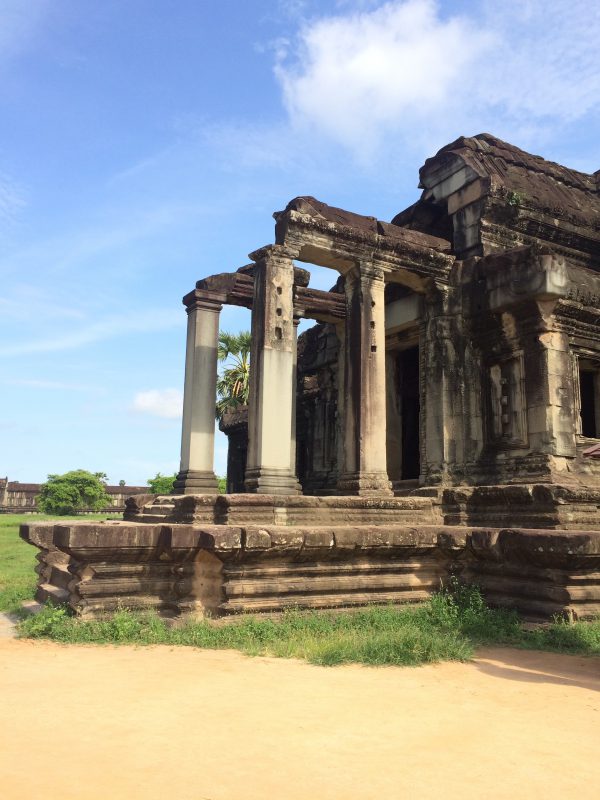 Angkor Wat
Angkor WatCambodia is a country symbolized by its glorious past and wounded present. A prevailing stereotype of Cambodia by the West and even within the Southeast Asia mediascape is that of a “post-communist” country ruled by a former Khmer Rouge leader and dominated by NGOs. Alongside the prevalent international image of genocide, refugees, poverty, and war, global media has often associated Cambodia to the Angkor Wat—thanks to the Hollywood Blockbuster Lara Croft Tomb Raider: The Cradle of Life (2003) and its leading actress Angelina Jolie’s constantly revisits due to her Cambodian adopted son. These two dominant, but somehow disjointed, narratives have engulfed the entangled history of state-building processes in the broader context of regional warfare in the post-World War II era.
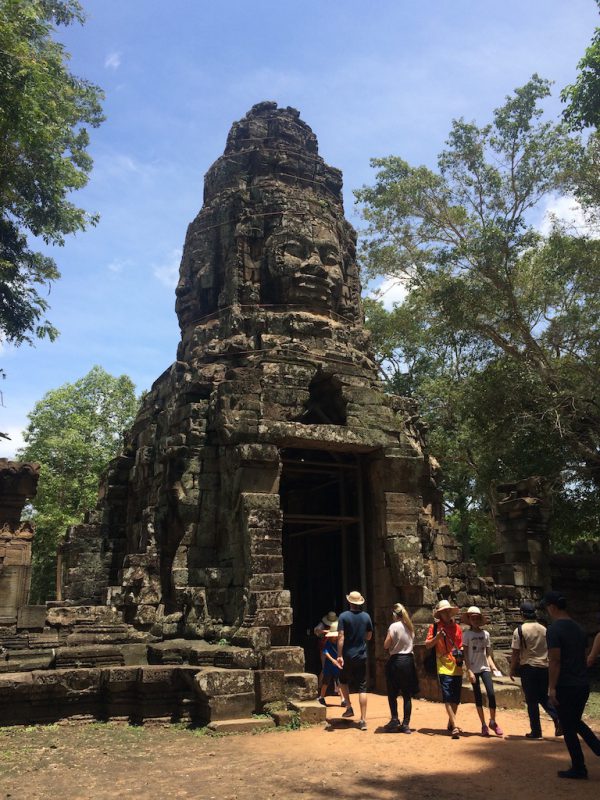 The Bayon
The BayonSince 1953, after the gradual pullout of the Japanese military force, Cambodia finally gained its independence from the French. As a former French protectorate, King Norodom Sihanouk’s power was sustained through the constitutional monarchy with an elected parliamentary form of government. Even though Sihanouk had decided to abdicate the throne in 1955, with the help of his political party Sangkum (which means “community of the common people”), he won the general election, officially becoming the prime minister of Cambodia. Regardless of the public’s reception of Sihanouk as a god-king and that he won governmental power through an official election process, Sihanouk was overthrown by a coup d’état in 1970 that subsequently led to his support of the Khmer Rouge and the inevitable civil war in 1975. Democratic Kampuchea was then established as the new government of Cambodia. From April 1975 to January 1979, the Khmer Rouge, under the leadership of Pol Pot, committed one of the most heinous massacres in modern history—the Cambodian genocide. As a result of Pol Pot’s political aspiration to return to Year Zero, a massive number of executions and countless acts of torture took place to eradicate traditional and foreign cultural influence. Recently, revisionist historians have shown that Operation Menu—launched by the United States Strategic Air Command as a bombing campaign in eastern Cambodia from 1969 to 1970—was a critical contributing factor to the sudden surge of the Khmer Rouge. The related historical complexity and shadowed public memories have also been addressed by artist Vandy Rattana in his documentary photo series, Bomb Ponds (2009).
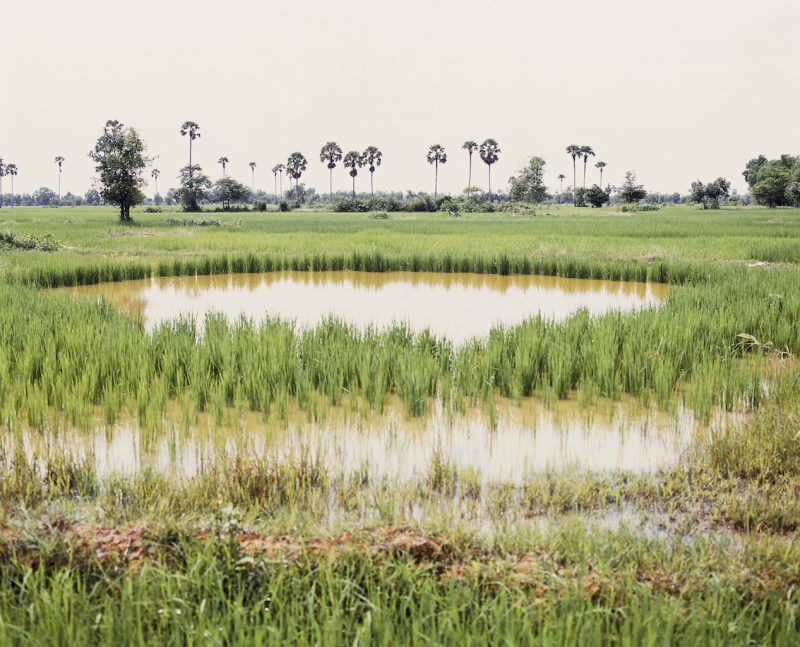 Bomb-Ponds_Takeo_by-Vandy-Rattana
Bomb-Ponds_Takeo_by-Vandy-Rattana
The government of Democratic Kampuchea was later overthrown by the Socialist Republic of Vietnam in 1979. The invasion further escalated anti-Vietnam sentiments, which still remain today. With support from the international community, peace efforts by France and the United Nations were established between 1989 and 1991, which is considered as the beginning of the resettlement process in Cambodia. Thousands of refugees were brought back from the border of Cambodia and Thailand. However, the arrival of the UN Transitional Authority in Cambodia (UNTAC) also led to another unintended legacy, which is what people refer to as “peacekeeper babies.” Unlike other countries’ nation-building processes in the region of Southeast Asia—which is in constant fluctuation between a heterogeneous past and the present desire for prosperity aligned with Western standards of modernization—the political identity of Cambodia, in relation to its historical past, is almost like an embroidery: interweaving colors of foreign influence with the nostalgic texture of an ancient kingdom.
We began our research with Siem Reap, where the old seat of the Khmer kingdom and center of religious and administrative power was, now becomes a locus of any discussion around the ways a people could reconcile its desires for greater democratic protections and economic development with the traditions of this ancient monarchy. One way is to clothe traditions as ‘heritage’, one that forms an essential founding story for this young nation, in ways that also position the activities of the ancient court as the cultural basis for the governance of a young state. For current activities in this mode of thinking, the emphasis is on preservation and transmission, and these projects could be seen throughout the wider Angkor complex, funded generously over decades by foreign governments, prominently among these are the French, German, and Japanese. Traces of conservationists from countries, including Japan, India, France, and others, were inscribed upon those heritage sites through their various preservation methods and materials. Broken sculptures were glued together with cement, and the arches of the corridor surrounding Angkor Thom were reinforced with the support of wooden structures. Considering the overwhelming amount of tour groups from the People’s Republic of China and Shenzhen-like urban landscapes, one can’t help but ask the question of whose past has been preserved for whom and what, not to mention the newly opened Angkor Panorama Museum that was financed, conceptualized, and executed by Mansudae, the largest art studio in North Korea and the house of masters of socialist realism.
Democratic protection is particularly crucial for domestic journalism. The English-language papers is generally perceived as having a greater degree of autonomy in their cultural reportage than their Khmer-language counterparts, which are commonly staffed with conservative editors. More worrying are the incidents of violence directed against journalists or those assisting them. In 2012, the eco-activist Chut Wutty was killed while escorting two journalists through a forest. In 2014, two journalists were killed, and last year Kem Ley, a political analyst and commentator prominent on local radio was shot in Phnom Penh at a petrol station. The latter assassination brought up other complexities; Kem Ley was known to direct ire at government policies using anti-Vietnamese sentiments, tapping into a convenient spring of historical mistrust between the two peoples. These racialized misgivings are endemic to national politics as well as to cultural practices, from the less-than-flattering depiction of the Vietnamese in Leang Seckon’s painting in the ‘Histories of the Future’ exhibition at the National Museum, its first institutional display of Cambodia’s contemporary art, to the social pressures faced by artists of mixed heritage, such as the filmmaker Sopheak Sao, to ‘pass’ for fully Cambodian, or to pass over ideas of cultural hybridity in silence. In an unusual cross-border project, Sopheak Sao invited the Vietnamese artist Tuan Mami to travel with her from the Mekong river to the Vietnam-Cambodia border, filming, collecting sand and stories, and remapping their psychological geographies along the way. Together, they created a presentation on the cultural and territorial porosity of the borders between the two lands, and the common materialities on both sides, such as palm. The project In/Visible Borderlines, shown at Meta House, culminated in a video installation, photographs and a series of common border markers sculpted out of brown palm sugar.
Sopheak Sao is also a documentary filmmaker with a keen eye on the life experiences of LGBT people under the long shadow of the Khmer Rouge. In 2012, Sopheak received international success with her a remarkable short film, Two Girls Against The Rain, the story of two women, who fell in love in the 1970s and survived the Khmer Rouge together, and now continue to reside in the same village where they first met. In their fifties when Sopheak met them, they are now the lynchpin of a large extended family of nieces and nephews and their children, as well as their respective siblings. One of the few queer documentaries to be made in mainland Southeast Asia, the film has been shown in Amsterdam, Berlin and San Francisco, but more importantly for the queer community in Phnom Penh, it was screened at a small Pride event at Meta House, one of a handful of nascent but growing self-organized LGBT-related activities in the country. At the moment, Sopheak is preparing to launch another feature-length documentary, Somewhere Under The Rainbow, which features Sou Sotheavy’s life story. Born in 1940, Sou is not only a transgender sex-work and a prominent LGBTI activist, but also one of the first individual providing her testimony in the Khmer Rouge Tribunal (ECCC) regarding the suffrage of sexual and gender minorities under Pol Pot’s regime.
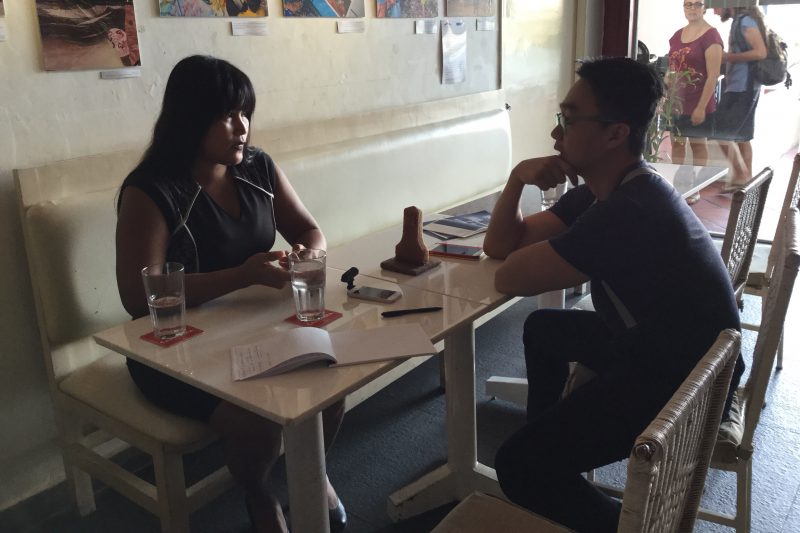 Inrerviewing Sopheak Sao
Inrerviewing Sopheak SaoSome parts of Cambodia’s recent past require more than the preservation and transmission of memories. Youk Chhang, a survivor of the Khmer Rouge terrors, who now directs the Documentation Center of Cambodia (DC-Cam), has previously pushed for the convening of the Khmer Rouge tribunal at the United Nations to bring the perpetrators of the violence to trial, and through his work at DC-Cam he has directed hundreds of thousands of documents in support of the charges of crimes against humanity. Worried about urbanite amnesia of the horrors suffered in the countryside, horrors still unameliorated by the slow arc of international justice, Youk Chhang decided that the ‘killing fields’ museums, as archives preserving the records of violence and death, cannot be the only institutional approaches to the genocide. His new project, the Sleuk Rith Institute, is in Youk Chhang’s description, a new kind of museum for Cambodia, committed to narrating the tragedies and horrors of the Khmer Rouge period, while maintaining an awareness of the other holocausts of the twentieth century. Most crucially, convinced of the need for peace education and peace-making, the Sleuk Rith Institute will also be an institute for higher learning through which Cambodia could take a leading role in preventing future episodes of xenocidal or genocidal violence. In close collaboration with the late architect Zaha Hadid, Chhang envisions a space inspired by the shelter and resilience of Cambodian trees. Hadid’s final design before her passing is a softly beguiling structure cladded in a humidity-resistant wood, with five individual buildings set into a plot of city parkland that Chhang has negotiated with the authorities for.
Kosal Khiev, on the other hand, embodies the complexity of the multidirectional memory in present-day Cambodia. He was born in a Thai refugee camp, lived in the United States, and was subsequently deported back to Cambodia after a felony conviction. Kosal and his exquisite craft of spoken word first drawn people attention in an Youtube video titled “My Asian Americana” produced by Cambodian-American performance artist Anida Yoeu Ali and her collaborative lab Studio Revolt. The video received overwhelming votes in the White House Video Challenge in 2011, but the video was eventually forced to withdraw due to its sensitive focus on Obama’s deportation policies.
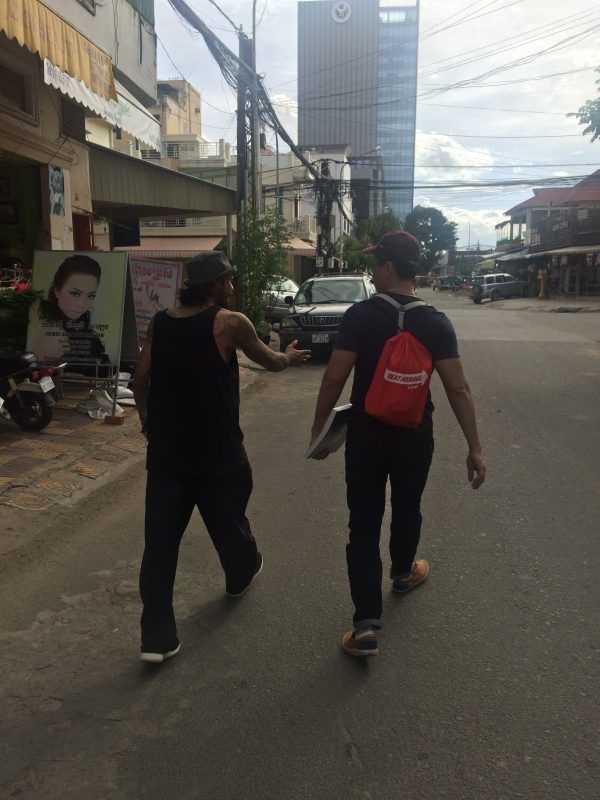 Waling with Kosal Khiev
Waling with Kosal KhievLike many of his fellow deportees, Kosal’s mother delivered him in the refugee camp in Thailand while the family was fleeing out from Cambodia, eventually settling in California. Just as the nearly 100,000 Cambodians who took refuge in California, Kosal and his siblings think of their family residence as home. At the age 16, Kosal was convicted of attempted murder and was sentenced to 14 years in prison. It is also in the prison where Kosal discovers his talent in spoken-word poetry both as an artistic achievement and a way to reconcile with himself. At present, he is an acclaimed poetry performer in Phnom Penh, teaching children through workshops and performance events, ever willing to collaborate with other artists and performers.
In Cambodian Son (2014), a feature-length documentary directed by Masahiro Sugano and produced by Anida Yoeu Ali, Kosal journeys to the London 2012 Cultural Olympiad to represent Cambodia. The film unfolds those fragile moments when Kosal was engulfed by the sorrow germinating from his traumatic past, a past he shares with many in the recent history of Cambodia. Regaining his attachment with Cambodia, without being able to speak a single Khmer, Kosal and other deportees are working out their motherless tongues to narrate own life experiences in modern day Cambodia. The question of returnees and deportees, and their narration of a Cambodian life, is a persisting one; over 15,000 have been deported since 1998, and just last month the Cambodian government had appealed the latest wave of deportations by the current US Administration.


